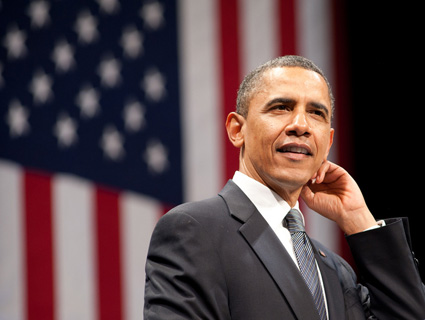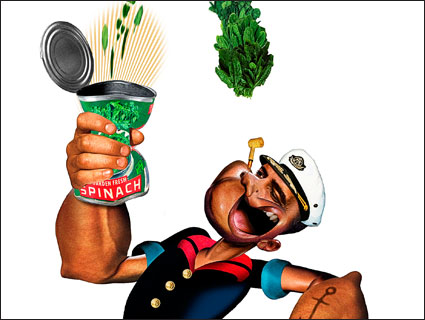
Obama at a San Francisco campaign rally in 2011<a href="http://www.flickr.com/photos/barackobamadotcom/5655674841/">Barack Obama</a>/Flickr
I will never understand why political campaigns think it’s helpful to telegraph their plans in public, but here’s the obligatory “inside the Obama campaign strategy” piece by John Heileman in New York magazine. To the extent it isn’t spin, it’s quite interesting, and since so much of it is unflattering, I’d have to guess that’s most of it.
The campaign principals (much like the administration itself in the first two years) are as convinced as ever that when it comes to brilliant strategy, they are the toppermost of the poppermost and show a level of confidence that borders on hubris. What seems to have changed since the last time around is that they are very, very worried about money.
As the piece reveals, the 2008 tale of the plucky campaign with its starry-eyed volunteers collecting its vast sums in $5 increments from school children and grandmas was pretty much a myth. They did break records for small donations, but the Obama campaign, like all presidential campaigns, collected most of its money from big donors—and Wall Street in particular. (As bank robber Willie Sutton said, “That’s where the money is.”) This time the Masters of the Universe are having themselves a monumental pout because the president hurt their feelings a couple of years ago when he called them fat cats, and so they’re giving more of their money this time to their soul brother Mitt Romney.
And unfortunately, the traditional liberal fat cats aren’t giving in nearly the amounts they expected, partially because the campaign, as is its wont, prematurely declared victory by touting its own fundraising prowess and telling everyone they were going to raise a billion dollars. Now all the rock stars and heiresses are saying, “Why do you need my measly quarter million?” (Also the super-PAC culture is much smaller on the left for a lot of reasons, including that the 2008 Obama campaign instructed big donors not to give to outside groups.) Still, they do expect to eke out a billion or so, while the Republicans will raise 50 percent more. Dear God.
Nobody knows what effect the tsunami of cash that’s about to crash on contested states will have on the voters. As David Axelrod says: “We’re actually about to test the limits of what money can do in politics, because there’s gonna be so much of it concentrated in so few states. The real question is, at what point is so much too much?” Those of you who live in those states should probably just plan on recording your favorite shows or reading a lot of books for the next few months. It’s not going to be pretty.
The campaign is placing its hopes on a couple of electoral-college strategies and demographics (the big new thing in Democratic circles) and intense fearmongering about the other side. Although that’s a much punier vision than the soaring promise of hope and change, I find it refreshingly realistic. It’s rooted in a realization that, in my opinion, came much too late.
Here’s Heileman describing how that happened:
The previous eight months had been hell for Obama. After the self-described “shellacking” his party suffered in the 2010 midterm elections, the president had sought to find a way to work with Republicans, to reestablish the post-partisan métier that animated his election. “For the first part of the year, he played what was largely an inside game,” says Obama’s longtime counselor David Axelrod. “The ideas being (a) maybe we can reason with the Republicans and come to some rational conclusions, and (b) maybe people really wanted to see cooperation. But that obviously didn’t work.”
Not just obviously, but screamingly so, as evinced by the reckless Republican brinkmanship over the debt ceiling and the collapse of the grand bargain on deficit reduction that Obama labored long to fashion with John Boehner. By the time the president took off for vacation to Martha’s Vineyard, recalls a senior White House official, “he was as frustrated as I’ve ever seen him.” Most irritating to Obama was the portrayal of him, on the right and left alike, as a terminally weak leader. “We found ourselves in the worst possible situation,” says Pfeiffer, “in which Republicans and some Democrats were using the same talking points to describe the president. That’s a moment of great political peril.”
Indeed it was. And while it may be impolite to point out how daft that entire strategy was, let me be rude: It was clear from the beginning of his term that the Republicans would not cooperate. They said it out loud and demonstrated it over and over again. It didn’t take the “shellacking” and its aftermath to understand their obstructive pattern. In the end, all that eight months of “outreach” did was shift the debate so far to the right that Democrats now consider it a victory if they can get the top 1 percent to throw in some tip money in exchange for slashing the social safety net.
I can understand why the White House might have gone that way. At the time the entire political media establishment was talking about the glory of being “the only grown-up in the room” and had visions of a Barack and Boehner version of their cherished Tip ‘n Ronnie trope. If the White House was listening to them during that period it’s entirely possible they thought this was a legacy moment.
Be that as it may, the campaign says the president learned his lesson just in time for the election and now he feels “liberated.” Certainly his rhetoric is sharper. What’s clear from this article is that Obama Campaign 2.0 is sure it is in for a very tough fight. Obviously the economy is the most important factor, and it seems they are just hoping to limp over the finish line on that one. The die was cast on that some time ago. The rest will be sound and fury. What remains to be seen is if it signifies anything important about a second term.
Speaking of which, has anybody heard anything about an agenda for that second term?
Heather Digby Parton is guest blogging this week while Kevin Drum is on vacation.










